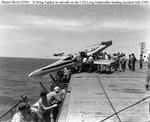parsifal
Colonel
Well, those landings are tight, but i would put this clip up against it and claim the landing was even tighter. HMAS Melbourne, 12000 ton Light Carrier . From Flight Deck Ops, the wing would pass over your head as the bird was landing. Tracker pilots getting their carrier qualifications.
After 1975, only RAN pilots were crazy enough to land on the old girl. Yanks thought our guys were nuts. In hindsight, they were probably right
View: https://www.youtube.com/watch?v=HoEElPX8hfQ
After 1975, only RAN pilots were crazy enough to land on the old girl. Yanks thought our guys were nuts. In hindsight, they were probably right
View: https://www.youtube.com/watch?v=HoEElPX8hfQ

